
"Annabel Lee" is the last complete poem composed by American author Edgar Allan Poe. Like many of Poe's poems, it explores the theme of the death of a beautiful woman. The narrator, who fell in love with Annabel Lee when they were young, has a love for her so strong that even angels are envious. He retains his love for her after her death. There has been debate over who, if anyone, was the inspiration for "Annabel Lee". Though many women have been suggested, Poe's wife Virginia Eliza Clemm Poe is one of the more credible candidates. Written in 1849, it was not published until shortly after Poe's death that same year.
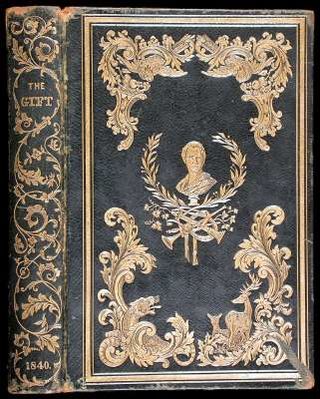
"William Wilson" is a short story by American writer Edgar Allan Poe, first published in 1839, with a setting inspired by Poe's formative years on the outskirts of London. The tale features a doppelgänger. It also appeared in the 1840 collection Tales of the Grotesque and Arabesque, and has been adapted several times.

"Al Aaraaf" is an early poem by American writer Edgar Allan Poe, first published in 1829. It tells of the afterlife in a place called Al Aaraaf, inspired by A'raf as described in the Quran. At 422 lines, it is Poe's longest poem.

"The Facts in the Case of M. Valdemar" is a short story by the American author Edgar Allan Poe about a mesmerist who puts a man in a suspended hypnotic state at the moment of death. An example of a tale of suspense and horror, it is also to a certain degree a hoax, as it was published without claiming to be fictional, and many at the time of publication (1845) took it to be a factual account. Poe admitted it to be a work of pure fiction in letters to his correspondents.
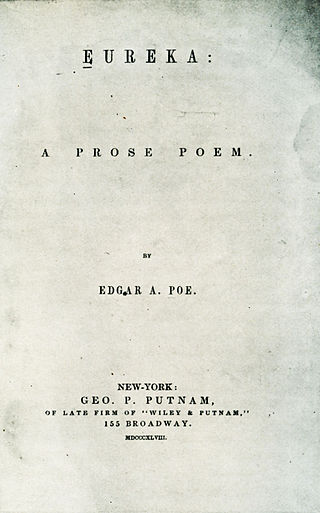
Eureka (1848) is a lengthy non-fiction work by American author Edgar Allan Poe (1809–1849) which he subtitled "A Prose Poem", though it has also been subtitled "An Essay on the Material and Spiritual Universe". Adapted from a lecture he had presented, Eureka describes Poe's intuitive conception of the nature of the universe, with no antecedent scientific work done to reach his conclusions. He also discusses man's relationship with God, whom he compares to an author. Eureka is dedicated to the German naturalist and explorer Alexander von Humboldt (1769–1859).
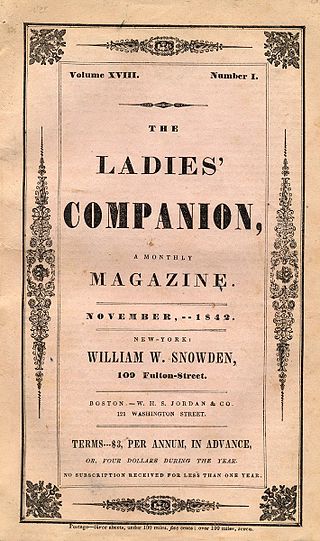
"The Mystery of Marie Rogêt", often subtitled A Sequel to "The Murders in the Rue Morgue", is a short story by American writer Edgar Allan Poe written in 1842. This is the first murder mystery based on the details of a real crime. It first appeared in Snowden's Ladies' Companion in three installments, November and December 1842 and February 1843. Poe referred to it as one of his "tales of ratiocination".
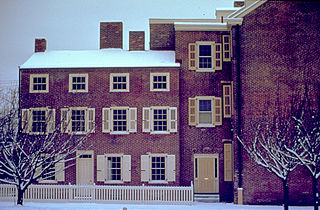
The Edgar Allan Poe National Historic Site is a preserved home once rented by American author Edgar Allan Poe, located at 532 N. 7th Street, in the Spring Garden neighborhood of Philadelphia, Pennsylvania. Though Poe lived in many houses over several years in Philadelphia, it is the only one which still survives. It was designated a National Historic Landmark in 1962.
"Metzengerstein: A Tale in Imitation of the German" is a short story by American writer and poet Edgar Allan Poe, his first to see print. It was first published in the pages of Philadelphia's Saturday Courier magazine, in 1832. The story follows the young Frederick, the last of the Metzengerstein family, who carries on a long-standing feud with the Berlifitzing family. Suspected of causing a fire that kills the Berlifitzing family patriarch, Frederick becomes intrigued with a previously unnoticed and untamed horse. Metzengerstein is punished for his cruelty when his own home catches fire and the horse carries him into the flame. Part of a Latin hexameter by Martin Luther serves as the story's epigraph: Pestis eram vivus—moriens tua mors ero.

"Eleonora" is a short story by American writer Edgar Allan Poe, first published in 1842 in Philadelphia in the literary annual The Gift. It is often regarded as somewhat autobiographical and has a relatively "happy" ending.
The Broadway Journal was a short-lived New York City-based newspaper founded by Charles Frederick Briggs and John Bisco in 1844 and was published from January 1845 to January 1846. In its first year, the publication was bought by Edgar Allan Poe, becoming the only periodical he ever owned, though it failed after only a few months under his leadership.

"Eulalie", or "Eulalie — A Song", is a poem by Edgar Allan Poe, first published in the July 1845 issue of The American Review and reprinted shortly thereafter in the August 9, 1845 issue of the Broadway Journal.

Thomas Dunn English was an American Democratic Party politician from New Jersey who represented the state's 6th congressional district in the House of Representatives from 1891 to 1895. He was also a published author and songwriter, who had a bitter feud with Edgar Allan Poe. Along with Waitman T. Barbe and Danske Dandridge, English was considered a major West Virginia poet of the mid 19th century.

"Never Bet the Devil Your Head: A Moral Tale" is a short story by American author Edgar Allan Poe, first published in 1841. The satirical tale pokes fun at the notion that all literature should have a moral and spoofs transcendentalism.
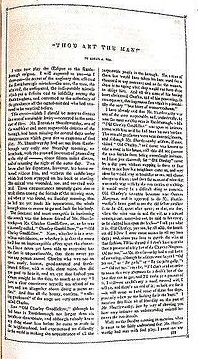
"Thou Art the Man", originally titled "Thou Art the Man!", is a short story by Edgar Allan Poe, first published in 1844. It is an early experiment in detective fiction, like Poe's "The Murders in the Rue Morgue", though it is generally considered an inferior story.
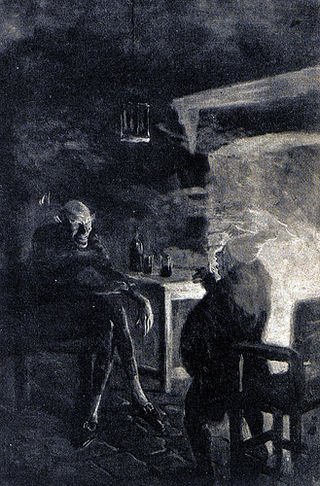
"Bon-Bon" is a comedic short story by Edgar Allan Poe, first published in December 1832 in the Philadelphia Saturday Courier. Originally called "The Bargain Lost", it follows Pierre Bon-Bon, who believes himself a profound philosopher, and his encounter with the Devil. The story's humor is based on the verbal interchange between the two, which satirizes classical philosophers such as Plato and Aristotle. The Devil reveals that he has eaten the souls of many of these philosophers.

The Edgar Allan Poe Cottage is the former home of American writer Edgar Allan Poe. It is located on Kingsbridge Road and the Grand Concourse in the Fordham neighborhood of the Bronx, New York, a short distance from its original location, and is now in the northern part of Poe Park.
William Henry Leonard Poe, often referred to as Henry Poe, was an American sailor, amateur poet and the older brother of Edgar Allan Poe and Rosalie Poe.

The works of American author Edgar Allan Poe include many poems, short stories, and one novel. His fiction spans multiple genres, including horror fiction, adventure, science fiction, and detective fiction, a genre he is credited with inventing. These works are generally considered part of the Dark romanticism movement, a literary reaction to Transcendentalism. Poe's writing reflects his literary theories: he disagreed with didacticism and allegory. Meaning in literature, he said in his criticism, should be an undercurrent just beneath the surface; works whose meanings are too obvious cease to be art. Poe pursued originality in his works, and disliked proverbs. He often included elements of popular pseudosciences such as phrenology and physiognomy. His most recurring themes deal with questions of death, including its physical signs, the effects of decomposition, concerns of premature burial, the reanimation of the dead, and mourning. Though known as a masterly practitioner of Gothic fiction, Poe did not invent the genre; he was following a long-standing popular tradition.
David Poe Jr. was an American actor and the father of Edgar Allan Poe.
"The Duc de L'Omelette" is a humorous short story by American writer Edgar Allan Poe. It was first published in the Philadelphia Saturday Courier on March 3, 1832, and was subsequently revised a number of times by the author.
















